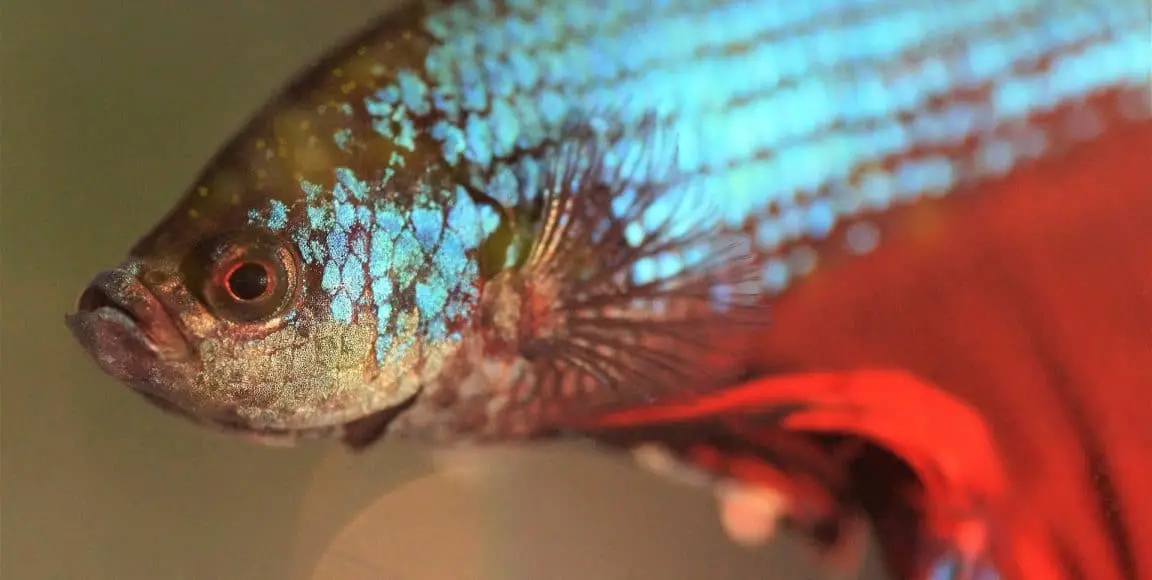Last Updated on September 12, 2021
You may suddenly notice that your betta looks as though it has specks of gold dust all over its body whenever it passes under the aquarium light. It may be suffering from Velvet disease! This can be a worrisome situation for betta fish keepers.
This article will discuss betta fish with velvet disease, one of the more common diseases of betta fishes. It will discuss the signs and symptoms you must look for, treatment, and prevention.
Table of Contents
What is Velvet disease?
Velvet disease or also known as Rust, Gold Dust Disease, Oödinium, and Velvet for short. An opportunistic parasite called Oödinium pilularis causes this.
It belongs to the genus Piscinoodinium. Also known as a dinoflagellate, it is a parasite classified by some as a protozoan and by others as algae because it has chlorophyll and can use photosynthesis.
This parasite can infect other aquarium fish in one tank because it spreads through the water. This disease is highly contagious and can be difficult to treat if you do not know the phases of the parasite’s life cycle.
The disease can also transfer from one fish tank to another. It may attach itself to things like plants, aquarium decor, and aquarium inhabitants like shrimp and snails.
Related: Betta Fish Swim Bladder Disease: What’s the Best Cure?
What is the life cycle of Oödinium?
The parasite has a life cycle similar to the well-known parasite which causes Ich. The single-celled parasite’s life cycle is divided into three major phases.
- The first phase of its life is as a tomont. It has a protective capsule, making it less susceptible to treatment. The parasite rests at the water’s floor and divides into 256 tomites! This may take 3 to 6 days. Once replication is complete, the tomonts will burst and release hundreds of dinospores into the water.
- The second phase is when these juvenile motile tomites, also called dinospores, swim about in search of a fish host, meanwhile using photosynthesis to grow and to fuel their search. These tomites can live without a host for 2 days. This is the phase where it is most susceptible to treatment. Remember that treatment targets the free-swimming stage of the parasite.
- Finally, the adolescent tomite finds and enters the slime coat of a host fish. This is the trophont phase which we can see. The crust formed around the parasite has a gold sheen that is actually the reaction of the fish’s body as it tries to isolate the parasite. Unfortunately, this makes the parasite less susceptible to the medication at this phase. The parasite under it is dissolving and consuming the fish’s cells. It needs only three to six days to reach full maturity before detaching to become a tomont once more.

What are the signs and symptoms of Velvet Disease?
The gold dust-like sheen on the surface of your betta fish is one of the giveaway signs that your betta has Velvet disease. We can see this when the betta reflects light at a certain angle. Using a flashlight may help detect it more.
Other signs and symptoms would include:
- Your betta constantly scratches its body against hard objects in the fish tank to dislodge the parasites.
- Lethargy is also common but may also be a symptom of other diseases.
- Loss of appetite is also common especially when the infection has taken over a huge portion of your betta fish.
- Loss of color because of the parasites accumulating on the betta fish’s body.
- Rapid, labored breathing because of parasites attacking the gills.
- Fins clamped against the body and are staying still in one area of the tank. It can be a sign that something is wrong.
- In advanced stages, the scales of your betta fish may look as though it peeled off!
Related: Best Betta Dropsy Treatment and Prevention
What is the treatment for Velvet disease?
- Contains one (1) API AQUARIUM SALT Freshwater Aquarium Salt 65-Ounce Box
- Promotes fish health and disease recovery with increased electrolytes
- Improves respiration for fish in freshwater aquariums
- Made from evaporated sea water for all-natural results
- Use when changing water, when setting up a new freshwater aquarium and when treating fish disease
Prices pulled from the Amazon Product Advertising API on:
Product prices and availability are accurate as of the date/time indicated and are subject to change. Any price and availability information displayed on [relevant Amazon Site(s), as applicable] at the time of purchase will apply to the purchase of this product.
- Do a 100% Water change. Clean your substrate using a gravel vacuum to suck out as much tomonts and tomites as possible. Replace with fresh water treated with a water conditioner to detoxify chlorine, chloramine, and heavy metals. Stress because of chlorine and chloramine toxicity will be counterproductive to the treatment.
- Increase the temperature of your aquarium slowly by 1 degree every hour. Our goal is to reach 85 degrees Fahrenheit or 29 degrees Celsius. Raise the temperature only by 1 degree every hour to avoid temperature shock to your betta fish. Stress because of sudden temperature change will be counterproductive to the treatment. The purpose of increasing the temperature is to speed up the parasite’s life cycle.
- Dim your tank light and reduce the time your light is turned on the entire duration you’re treating your betta fish. The parasite has chlorophyll in its cells so it can use photosynthesis. Reducing the light source will prevent the parasite from being able to use photosynthesis.
- Take out any live plants because the treatment can cause damage to live plants.
- Remove any carbon-based filtration media. This will render any medication you use ineffective.
- Start adding aquarium salt. API Aquarium Salt is a popular brand. Add 1 rounded tablespoon for every 5 gallons or 0.5 teaspoons for every gallon of aquarium water. You should add salt gradually over a 3 to 4-hour period so you don’t shock your fish. The higher salinity makes it less habitable for parasites.
- You can use medications such as Malachite Green by Kordon and CopperSafe by Mardel. These have substances that will kill the parasite during its Tomite free-swimming stage. Malachite green can stain your tank though so take out as much decoration you don’t want stained. Copper will kill shrimps and snails so do not use this if your betta has shrimps or snails as tank mates. Use medication according to the recommended dosage.
- Monitor your betta fish for signs of improvement. The gold dust-like particles should start disappearing and your betta should become more comfortable and more active. The appetite should return to normal. Velvet is easy to treat, but fatal if left unchecked.
How much time does the treatment take?
Oödinium will only last 2 days in its tomite stage swimming freely in the water column without finding a new host. If it finds a new host, then it will live for 2 weeks. To make sure you’ve eradicated all traces from your tank it will take 3-4 weeks on average.
If symptoms persist, consult a veterinarian who specializes in fish care. Veterinarians will be able to better diagnose, treat, and give advice about the diseases which may affect your betta fish.
How to prevent Velvet disease from happening?
Be a responsible betta fish owner and follow a maintenance schedule to clean your pet’s home regularly. This is one of the best pieces of advice to ensure that your betta is healthy and can fight off disease. Good filtration, correct water parameters, optimal temperature, and proper diet will allow your betta fish to thrive.
Give your betta fish a good diet. Food such as bloodworms, daphnia, mosquito larvae, and brine shrimp are all great in combination with high-quality betta pellets. A high protein diet will allow your betta’s immune system to fight off infections more effectively.
Having tank mates is an option for betta fish. Being a part of a community tank can be a superb source of stimulation for your betta fish. When setting up a community tank, quarantine any new fish that you will introduce into the aquarium community. This may take at least 2 weeks or up to 1 month just to make sure your new fish do not have any disease which can infect the other members of the community.

